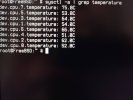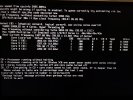FreeBSD 12.4-RELEASE r372781 GENERIC amd64
CPU: Intel(R) Core(TM) i5-3320M CPU @ 2.60GHz (2594.17-MHz K8-class CPU)
------------------------- on AC power -------------------------
system power profile changed to 'performance'
acpi_acad0: On Line
hw.acpi.cpu.cx_lowest: C8
dev.cpu.0.cx_method: C1/mwait/hwc C2/mwait/hwc
dev.cpu.0.cx_usage_counters: 176 27673
dev.cpu.0.cx_usage: 0.63% 99.36% last 11us
dev.cpu.0.cx_lowest: C8
dev.cpu.0.cx_supported: C1/1/1 C2/2/80
root@t430s:~ # i7z
Cpu speed from cpuinfo 2593.00Mhz
cpuinfo might be wrong if cpufreq is enabled. To guess correctly try estimating via tsc
Linux's inbuilt cpu_khz code emulated now
True Frequency (without accounting Turbo) 2593 MHz
CPU Multiplier 26x || Bus clock frequency (BCLK) 99.73 MHz
Socket [0] - [physical cores=2, logical cores=4, max online cores ever=2]
TURBO ENABLED on 2 Cores, Hyper Threading ON
Max Frequency without considering Turbo 2692.73 MHz (99.73 x [27])
Max TURBO Multiplier (if Enabled) with 1/2/3/4 Cores is 33x/31x/31x/31x
Real Current Frequency 1209.57 MHz [99.73 x 12.13] (Max of below)
Core [core-id] :Actual Freq (Mult.) C0% Halt(C1)% C3 % C6 % C7 % Temp VCo
Core 1 [0]: 1209.57 (12.13x) 1 0.265 0 99.6 0 42 0.82
Core 2 [1]: 1197.65 (12.01x) 1 0.302 0 99.6 0 42 0.82
C0 = Processor running without halting
C1 = Processor running with halts (States >C0 are power saver modes with cores idling)
C3 = Cores running with PLL turned off and core cache turned off
C6, C7 = Everything in C3 + core state saved to last level cache, C7 is deeper than C6
Above values in table are in percentage over the last 1 sec
[core-id] refers to core-id number in /proc/cpuinfo
'Garbage Values' message printed when garbage values are read
Ctrl+C to exit
root@t430s:~ # t430stat
Sun Feb 19 15:43:31 AEDT 2023 dev.cpu.0.freq: 1200
cpu0: 1.00% 98.99% last 2584us 41.0C tz0: 40.1C
cpu1: 1.10% 98.89% last 28840us 40.0C { 0.06 0.14 0.10 }
cpu2: 1.05% 98.94% last 5182us 48.0C { LAPIC one-shot }
cpu3: 1.01% 98.98% last 5467us 47.0C { t.cnt: TSC-low }
dev.acpi_ibm.0.fan: 1 (auto) _level: 0 _speed: 65535
high capacity: 94% time: unknown
rate: 0 mW voltage: 11975 mV
root@t430s:~ #
------------------------- on battery -------------------------
system power profile changed to 'economy'
acpi_acad0: Off Line
hw.acpi.cpu.cx_lowest: C8
dev.cpu.0.cx_method: C1/mwait/hwc C2/mwait/hwc C3/mwait/hwc
dev.cpu.0.cx_usage_counters: 78 18 5640
dev.cpu.0.cx_usage: 1.35% 0.31% 98.32% last 90us
dev.cpu.0.cx_lowest: C8
dev.cpu.0.cx_supported: C1/1/1 C2/2/59 C3/3/87
Cpu speed from cpuinfo 2593.00Mhz
cpuinfo might be wrong if cpufreq is enabled. To guess correctly try estimating via tsc
Linux's inbuilt cpu_khz code emulated now
True Frequency (without accounting Turbo) 2593 MHz
CPU Multiplier 26x || Bus clock frequency (BCLK) 99.73 MHz
Socket [0] - [physical cores=2, logical cores=4, max online cores ever=2]
TURBO ENABLED on 2 Cores, Hyper Threading ON
Max Frequency without considering Turbo 2692.73 MHz (99.73 x [27])
Max TURBO Multiplier (if Enabled) with 1/2/3/4 Cores is 33x/31x/31x/31x
Real Current Frequency 1196.72 MHz [99.73 x 12.00] (Max of below)
Core [core-id] :Actual Freq (Mult.) C0% Halt(C1)% C3 % C6 % C7 % Temp VCo
Core 1 [0]: 1196.72 (12.00x) 1.86 1.58 0 0 97.6 42 0.81
Core 2 [1]: 1195.83 (11.99x) 1 2.27 0 0 97.6 42 0.81
root@t430s:~ # t430stat
Sun Feb 19 15:54:39 AEDT 2023 dev.cpu.0.freq: 1200
cpu0: 0.36% 0.32% 99.31% last 10416us 42.0C tz0: 39.1C
cpu1: 0.48% 0.30% 99.20% last 771us 42.0C { 0.14 0.13 0.09 }
cpu2: 0.37% 0.27% 99.35% last 1752us 45.0C { LAPIC one-shot }
cpu3: 0.36% 0.22% 99.40% last 840us 45.0C { t.cnt: TSC-low }
dev.acpi_ibm.0.fan: 1 (auto) _level: 0 _speed: 65535
discharging capacity: 91% time: 2:32
rate: 10527 mW voltage: 11658 mV



